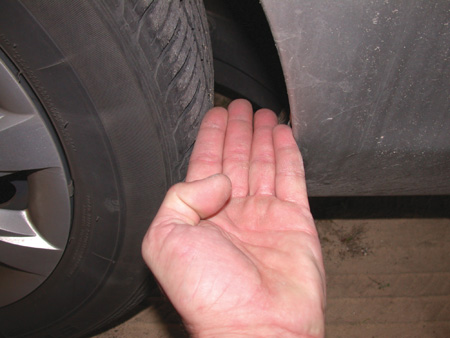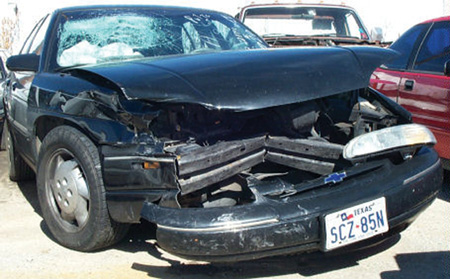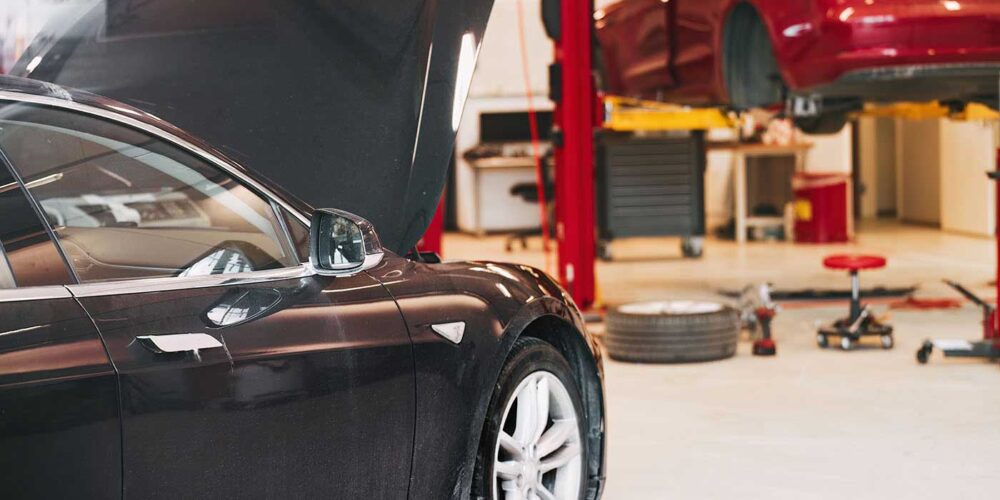

To measure or not to measure? That’s not the question, because there’s no question about it – you must take measurements to accurately diagnose the condition of a collision-damaged vehicle. But there should also be no questions about when to measure the vehicle. The first measurement should take place shortly after the first time you see the vehicle. Do your estimators take any measurements when diagnosing damages? If not, why not?
You can’t expect to accurately diagnose the condition of a collision-damaged vehicle without the aid of at least one measuring device. The old “hand between the fender and wheel on each side to see if the control arm is bent” doesn’t always convince me. It only takes a minute to measure the wheelbase on both sides of the vehicle to determine the difference between the two sides.
Do you keep a tram gauge in your office? How about a digital measuring system? Many shops these days are utilizing single work bays that are separated from the rest of their production areas to write estimates. Many of these estimating areas are equipped with a mechanic’s lift, maybe a set of basic hand tools and measuring equipment dedicated solely to the diagnosis of damage.
Whether you have a large facility that can support a separate diagnosis area or you’re a small, one- to three-person operation, the need to measure the vehicles remains the same. If you’re not taking measurements, then you’re not diagnosing the extent of the damages. Instead, you’re just guessing what the extent of the damage will be based on what you’ve experienced with other vehicles. What are the odds that the impact was of the same intensity and came from the same angle as all the other similar vehicles you’ve repaired?
Customer Education
Another good reason to thoroughly measure a car arises when the vehicle owner happens to be standing right there. If you use the tram gauge to show your customer the physical evidence of a sway in the vehicle’s front end, he or she can better understand at least one of the differences between your $3,500 estimate and the $850 sheet the clown down the street wrote for the same car. The more you educate your customer, the more you can compete against and win customers from the lesser quality repairers in this trade.
Of course, if you use a digital measuring system to take a quick measurement of the damaged area, you can print a sheet and show your customer the extent of the damage that way. With the new technology available these days, measuring cars should be getting easier and more accurate. And with the increased competition in the market, the prices are starting to come down a bit as well.
Some of the newer systems on the market are available in smaller basic packages for just over $10,000 and can take a basic initial measurement of most vehicles in 15 minutes or less. If a tech measures the car while the service writer starts working on the estimate, you won’t tie up much of the customer’s time but will make a good impression by showing him or her where damage is located in the vehicle’s structure.
When the vehicle comes into the shop for repairs, do the techs get an initial measurement right away or do they make a few preliminary pulls first? I’ve lost count of how many times I’ve seen techs leave the measuring system in the corner to collect dust until they’ve spent a few hours pulling on the car until it “looks close.” Heck, I’ve done it myself too many times, but I always end up measuring the car one way or another before it comes off the frame machine. Even if I spend a couple hours or more thoroughly measuring the vehicle, it beats the hours I would spend fighting with parts to get them to fit and align nicely. But in body shops all over the country, expensive measuring systems are collecting dust in a corner. Why is that?
Too Complicated?
Some techs say that measuring systems are difficult to use. I’ve heard that some of the machines operate poorly in certain atmospheres. Other techs say some of the machines are difficult to set up under the vehicles, while other machines, though easier to set up, have to be removed when making pulls. Then the tech has to set up the system again to measure the vehicle after pulling. Most techs seem to agree that the databases of all the measuring systems have some inaccuracies, but many techs, including myself, don’t let that stand in the way of a good repair. If the system says my right frame rail is 12 mm high and my left rail is 11 mm high, but the sheet metal fits and there are no buckles or kinks in either rail, I don’t try to pull the front end down 11 mm. That’s when I either look for different measuring points on the rails or accept that there’s incorrect data in the system.
Shop owners have also told me that some of the companies lack tech support or that the updates are expensive. One shop owner described a measuring system that completely shuts down and won’t let you measure a car until the most recent update is installed. So if your update is lost in the mail or you just don’t want to pay for the updates anymore, you can’t use the measuring system even to measure older cars that are in the existing databank. But then I’ve also heard of more than one company making older systems obsolete by discontinuing the availability of hardware, software and even tech support.
On the other hand, the technology I’ve seen demonstrated at trade shows and in shops has always seemed easy to set up and use. I’ve only had the opportunity to use a couple different systems on an ongoing basis out in the field, but for the most part, I didn’t experience the kind of difficulty I’ve heard other techs around the country were having. While no measuring system is going to be perfect, I find it difficult to believe that every system on the market is flawed beyond usability.
One situation I encountered that sticks in my mind came up on a Ford Taurus that had barely more than a torn front bumper cover. The car had less than 4,000 miles and no signs of any previous damage, but a floor pan cross member under the back seat showed up 19 mm off. But it was only off on one side. I measured several other Tauruses of the same year and discovered that the same cross member was always around 18 to 20 mm off. So I used a different measuring point instead of turning this discovery into an excuse to not use the measuring system. And guess what? I found a flaw in the system but, still, the flaw didn’t keep me from measuring the car.
Charge for It
Now riddle me this, shop owners: Why did you drop $30,000 on a measuring system that you were most likely told is the easiest to use and the most accurate on the market, only to have it sit in a corner in your shop and collect dust, rust and mouse droppings? Is the measuring system actually that flawed? Or are your techs just not interested in using it? I mean, you are getting your techs compensated for setup of the system as well as measuring and diagnosis of damage, right?
As I’ve said for years, if you’re still accepting the same old “set up measure pull and square” routine from insurers, you’re cheating yourself, your techs and your customers as well. The last time I checked, the data providers were pretty clear on what “setup” time is and why it must be determined by the repair shop. Your “setup” involves putting the vehicle in the holding system on your frame equipment and removing the vehicle from the frame equipment when you’re finished pulling. Setting up a measuring system and diagnosing the extent of the damage is not part of that process.
If the technician has to set up a measuring system and use it throughout frame repairs, this procedure is separate from setting up the vehicle in the holding system. Charge a fee for the setup of the measuring system and charge a fee for the diagnosis. Most doctors will charge you for an office visit and a diagnosis before any treatment has begun. Why are body shops providing the equivalent of this service for free? Certainly you don’t expect techs to measure every car for free, do you?
If the compensation for setup of the system and diagnosis of the damage isn’t there, it’s still in the best interest of all for the tech to set up the system and ensure the vehicle is returned to factory specs. But most techs aren’t ready and willing to add more procedures to the list of ones they perform for free, and that’s why so many will gamble on guesses. Do you spend two and a half hours playing with a computer program, or do you spend half an hour slotting holes and shimming sheet metal to look like it fits? If it pays zero dollars either way, I know what most techs out in the field will do.
Cheating = Fraud
On the other side of that coin, many techs probably won’t use the measuring system even if they are compensated for the procedure. I hate to admit the number of times I’ve seen techs cheat a measuring system by propping targets into position with blocks of wood or masking tape to get the reading they want. How can anybody expect people to pay for fraud if you want to maintain any reasonable level of integrity? Whether you cheat the system to make the damage appear worse or to make it appear repaired to OEM specifications, the sheet you print showing the measurements is a fraudulent document.
What it boils down to is, regardless of what type of measuring device you use, measuring and diagnosing damage are among those procedures you should naturally perform on most of the vehicles you repair. If you’re not measuring correctly, you’re probably leaving damages unrepaired somewhere. But only a small handful of the collision repair industry is willing to charge administrative fees and shop labor for the training, experience and effort required to thoroughly and accurately diagnose the extent of collision damage sustained by any given vehicle.
So what’s everybody else waiting for? When will the rest of you catch up to those few who are measuring for money? The time is past due for shop owners and managers to charge for the necessary measuring and diagnosis that your estimators as well as your techs should perform. And it’s also way past time for the techs to measure and diagnose each job thoroughly and accurately and repair it correctly. Measure and repair correctly if for no other reason than that you never know who might inspect that job after you’re finished.
Writer Paul Bailey, a contributing editor to BodyShop Business, has been a collision repairman for more than 20 years and is an avid photographer, writer and artist. Currently at work on what he expects to be his first book, Bailey resides in Florida with his wife, Cathy. Send all hate mail (and compliments) to [email protected].













